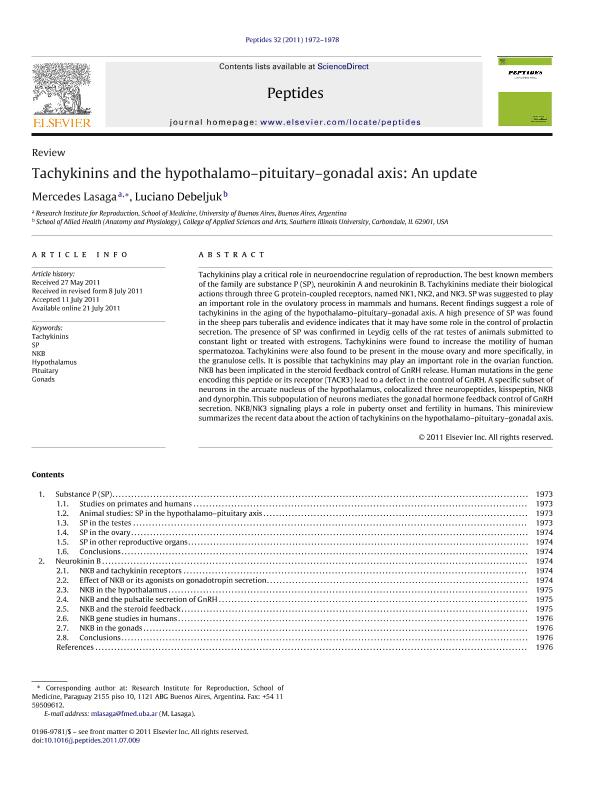Mostrar el registro sencillo del ítem
dc.contributor.author
Lasaga, Mercedes Isabel

dc.contributor.author
Debeljuk, Luciano
dc.date.available
2017-04-10T21:08:53Z
dc.date.issued
2011-09
dc.identifier.citation
Lasaga, Mercedes Isabel; Debeljuk, Luciano; Tachykinins and the hypothalamo–pituitary–gonadal axis: an update; Elsevier Inc; Peptides; 32; 9; 9-2011; 1972-1978
dc.identifier.issn
0196-9781
dc.identifier.uri
http://hdl.handle.net/11336/15116
dc.description.abstract
Tachykinins play a critical role in neuroendocrine regulation of reproduction. The best known members of the family are substance P (SP), neurokinin A and neurokinin B. Tachykinins mediate their biological actions through three G protein-coupled receptors, named NK1, NK2, and NK3. SP was suggested to play an important role in the ovulatory process in mammals and humans. Recent findings suggest a role of tachykinins in the aging of the hypothalamo–pituitary–gonadal axis. A high presence of SP was found in the sheep pars tuberalis and evidence indicates that it may have some role in the control of prolactin secretion. The presence of SP was confirmed in Leydig cells of the rat testes of animals submitted to constant light or treated with estrogens. Tachykinins were found to increase the motility of human spermatozoa. Tachykinins were also found to be present in the mouse ovary and more specifically, in the granulose cells. It is possible that tachykinins may play an important role in the ovarian function. NKB has been implicated in the steroid feedback control of GnRH release. Human mutations in the gene encoding this peptide or its receptor (TACR3) lead to a defect in the control of GnRH. A specific subset of neurons in the arcuate nucleus of the hypothalamus, colocalized three neuropeptides, kisspeptin, NKB and dynorphin. This subpopulation of neurons mediates the gonadal hormone feedback control of GnRH secretion. NKB/NK3 signaling plays a role in puberty onset and fertility in humans. This minireview summarizes the recent data about the action of tachykinins on the hypothalamo–pituitary–gonadal axis.
dc.format
application/pdf
dc.language.iso
eng
dc.publisher
Elsevier Inc

dc.rights
info:eu-repo/semantics/openAccess
dc.rights.uri
https://creativecommons.org/licenses/by-nc-nd/2.5/ar/
dc.subject
Tachykinins
dc.subject
Hypothalamus
dc.subject
Pituitary
dc.subject
Gonads
dc.subject
Reproduction
dc.subject
Sp
dc.subject
Nkb
dc.subject.classification
Otras Medicina Básica

dc.subject.classification
Medicina Básica

dc.subject.classification
CIENCIAS MÉDICAS Y DE LA SALUD

dc.title
Tachykinins and the hypothalamo–pituitary–gonadal axis: an update
dc.type
info:eu-repo/semantics/article
dc.type
info:ar-repo/semantics/artículo
dc.type
info:eu-repo/semantics/publishedVersion
dc.date.updated
2017-04-07T14:27:29Z
dc.journal.volume
32
dc.journal.number
9
dc.journal.pagination
1972-1978
dc.journal.pais
Estados Unidos

dc.description.fil
Fil: Lasaga, Mercedes Isabel. Universidad de Buenos Aires. Facultad de Medicina; Argentina. Consejo Nacional de Investigaciones Científicas y Técnicas; Argentina
dc.description.fil
Fil: Debeljuk, Luciano. Southern Illinois University; Estados Unidos
dc.journal.title
Peptides

dc.relation.alternativeid
info:eu-repo/semantics/altIdentifier/url/http://www.sciencedirect.com/science/article/pii/S0196978111002841
dc.relation.alternativeid
info:eu-repo/semantics/altIdentifier/doi/http://dx.doi.org/10.1016/j.peptides.2011.07.009
Archivos asociados
